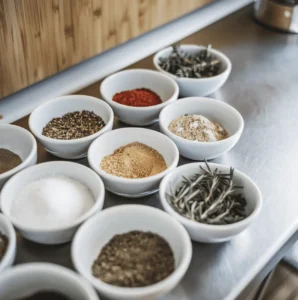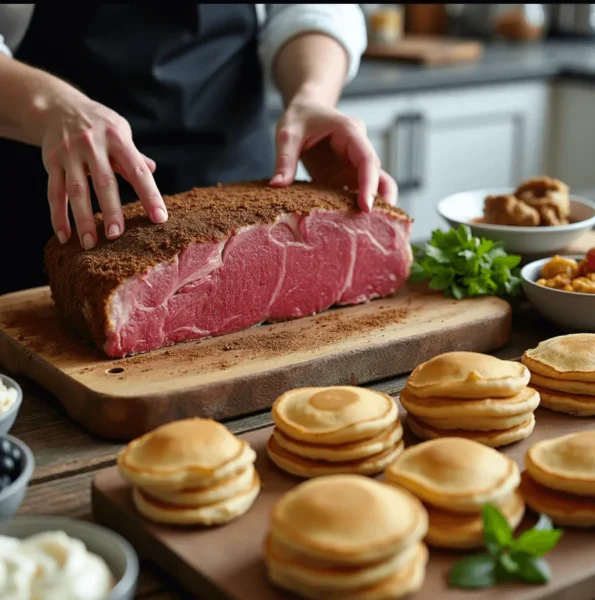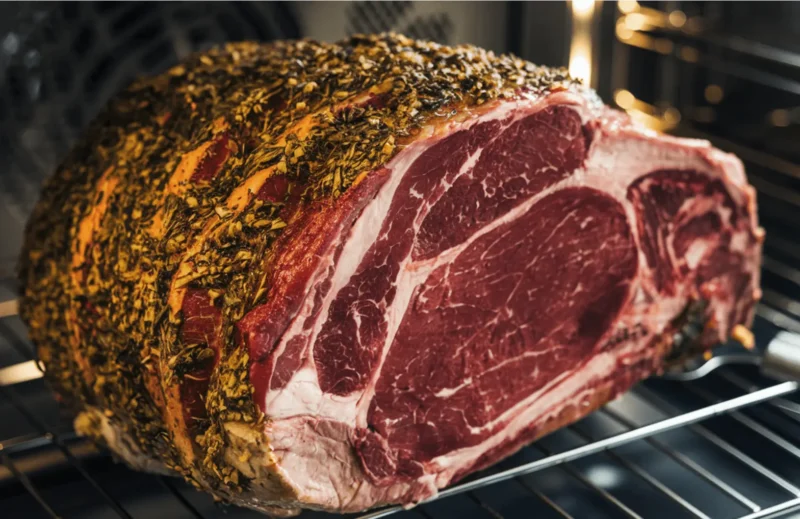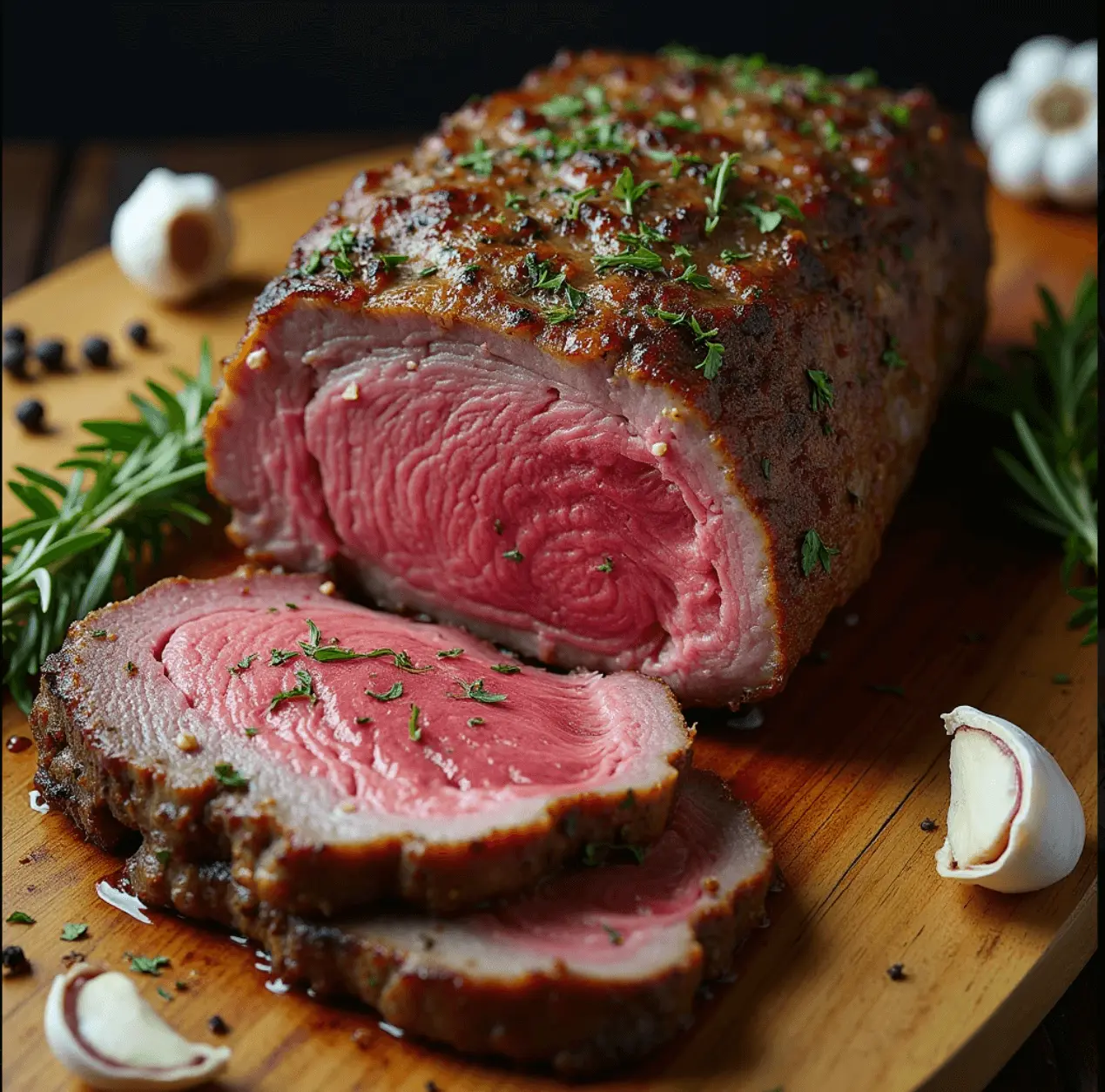To cook a perfect prime rib, use Prime Rib Seasoning. It enhances the meat’s natural flavors. With the right blend of spices and herbs you can elevate your dish from simple to special. This guide will detail how to make perfect Prime Rib Seasoning for your prime rib. Every bite will be a savory delight.
Table of Contents
Overview of Prime Rib
Prime rib is a cut of beef that is prized for its marbling and flavor. Proper seasoning enhances the taste, helping to tenderize the meat while adding depth. For a tasty crust, use salt, black pepper, garlic powder, onion powder, thyme, and rosemary. You may like a traditional mix, herb crust, spicy kick, or an Asian twist. The right seasoning technique is crucial. A dry rub or a wet rub, both offering unique benefits. For best results, apply the seasoning evenly. Allow the flavors to penetrate the meat overnight.
If you’re interested in exploring other seasoning methods, check out our guide on meatloaf seasoning for inspiration.
Importance of Proper Seasoning
Cooking your seasoned prime rib requires careful roasting and precise temperature control. You must also let it rest to ensure juiciness. By following these tips, you can master Prime Rib Seasoning. You’ll create a roast that’s perfect for any occasion. For more inspiration, check out: 1. smoked meatloaf recipe, 2. meatloaf seasoning, and 3. why is my meatloaf still pink in the middle. Happy cooking!
Proper seasoning is essential for prime rib. It boosts flavor and tenderizes the meat, ensuring even the best cuts don’t taste bland. With the right seasoning, every bite becomes a savory experience. For additional tips on achieving perfection, read our smoked meatloaf recipe to explore unique smoking techniques.
Overview of Prime Rib Prime rib, or standing rib roast, is a prized cut of beef. It has great marbling and flavor. This cut comes from the primal rib section of the cow and includes the ribeye muscle. Prime rib is a holiday and special occasion favorite. What makes it a centerpiece is its taste and tender texture. For more information on the different cuts of beef, check out this guide.
Understanding Prime Rib
Prime Rib’s Characteristics. It is famous for its rich marbling. It makes the meat tender and flavorful. This cut of meat is often preferred. Juicy and flavorful, even when it cooked to well-done. The marbling helps to baste the meat internally as it cooks, resulting in a succulent roast.
Why Seasoning Matters Seasoning is vital. It boosts the meat’s natural flavors and adds new tastes. The right spices can enhance the beef’s richness and create a balanced, flavorful dish. For more tips on cooking prime rib, visit this resource.
Choosing the Right Seasonings
Salt: The Foundation Salt is the fundamental seasoning for prime rib. It helps in drawing out moisture from the meat and forming a flavorful crust when roasted. Kosher salt is preferred for its larger crystals. It covers more surface area and penetrates the meat better.

Black Pepper: Adding Warmth Black pepper adds heat and enhances the prime rib’s flavor. Freshly ground black pepper is recommended for its potent aroma and flavor.
Garlic Powder: Depth and Complexity Garlic powder adds a deep, earthy flavor. It pairs wonderfully with beef. It provides complexity without overpowering the meat.
Onion Powder: Sweetness and Savory Notes Onion powder adds a sweet, savory depth to the mix. It complements the prime rib’s natural flavors.
Thyme: Earthy and Minty Flavor Thyme has an earthy, slightly minty taste. It goes well with the strong flavor of prime rib. It’s a versatile herb that enhances the meat’s profile.
Rosemary: Piney and Fragrant Aroma It has a piney, fragrant aroma. It pairs beautifully with beef.
Its strong, distinct flavor can elevate the seasoning to new heights.
Varieties of Seasoning
A traditional prime rib seasoning mix has four ingredients. They are salt, black pepper, garlic powder, and onion powder. This combo is simple yet effective. It lets the meat’s flavors shine.
Herb-Crusted Seasoning For a more complex flavor profile, consider an herb-crusted seasoning. This mix includes fresh or dried herbs: thyme, rosemary, and oregano. It is combined with salt and pepper. The herbs create a flavorful crust that adds texture and depth to the roast.
Spicy Seasoning Blend If you decide on a piece of warmth, a spicy seasoning combination is an brilliant preference. Add cayenne pepper or overwhelmed purple pepper flakes to the traditional blend for a kick of spiciness. This combo is perfect for people who revel in a ambitious, zesty flavor.
Asian-inspired Seasoning For an exotic twist, try an Asian-inspired seasoning blend. This might include soy sauce, ginger, garlic, and a touch of brown sugar. The mix of sweet and savory flavors enhances the prime rib.
Seasoning Techniques
The dry rub method involves applying a mix of dry seasonings directly onto the meat. This technique helps in forming a flavorful crust when the meat is roasted. To ensure even coverage, pat the prime rib dry with paper towels before applying the rub. Massage the seasoning into the meat, covering all sides thoroughly.

Wet Rub Method The wet rub method uses a paste of seasonings. It is made with a liquid, like olive oil or mustard. This paste is then applied to the meat, creating a thick coating that adheres well during cooking. The wet rub method is ideal for adding a richer flavor and more moisture to the roast.
Check out our tips on avoiding common mistakes like over-seasoning in our guide to why is my meatloaf still pink.
Application Tips
- Apply the seasoning at least 24 hours before cooking to allow the flavors to penetrate the meat.
- Wrap the seasoned prime rib in plastic wrap and refrigerate it overnight.
- Remove the meat from the fridge. Let it sit at room temperature for about an hour before cooking.
Preparing the Prime Rib
Trimming Excess Fat Before seasoning, trim any excess fat from the prime rib. Some fat adds flavor and moisture. But, too much can cause flare-ups when cooking. Aim to leave a thin layer of fat on the meat for optimal results.
Soaking the prime rib in a flavorful liquid can enhance its taste. Use beef broth or a marinade. This step is optional but can add an extra layer of flavor and help keep the meat moist during cooking.
Applying Seasonings Use a dry or wet rub. Apply the seasonings evenly across the meat’s entire surface. Make sure to cover all sides, including the ends. For a richer flavor, insert slivers of garlic into small cuts on the meat before seasoning it.
Cooking the Prime Rib
Roasting Techniques Roasting is the most common method for cooking prime rib. Preheat your oven to 450°F (230°C) to sear the meat. Then, lower the temperature to 325°F (160°C) to cook it through. This technique ensures a flavorful crust and a juicy interior.

Temperature and Time Guidelines
- Rare: 120-125°F (49-52°C)
- Medium Rare: 130-135°F (54-57°C)
- Medium: 140-145°F (60-63°C)
- Well Done: 150-155°F (65-68°C)
Use a meat thermometer to check the internal temperature and avoid overcooking. The meat will keep cooking after you remove it from the oven. So, take it out a few degrees before it reaches the desired temperature.
Resting the Meat Allow the prime rib to rest for at least 20 minutes after cooking. This step is crucial. It lets the juices redistribute in the meat. This makes a tender, juicy roast.
Enhance your roast with tips from our guide on herb-roasted turkey recipe, applying similar techniques to elevate flavor.
Expert Tips and Tricks
Enhancing Flavor with Aromatics. Besides seasonings, use aromatics to boost prime rib’s flavor. Try garlic, onions, and fresh herbs. Place these aromatics around the meat in the roasting pan. They will infuse the roast with their fragrance as it cooks.
Using Fresh vs. Dried Herbs Fresh herbs often have a more vibrant flavor compared to dried herbs. However, dried herbs can be more concentrated and easier to store. When using dried herbs, use half the amount of fresh herbs to avoid overpowering the meat.
Common Mistakes to Avoid
- Over-seasoning: Season the meat well, but don’t overpower the prime rib’s natural flavor.
- Not letting the meat warm before cooking can cause uneven cooking.
- Skipping the resting period: Resting the meat is crucial for maintaining its juiciness.
Frequently Asked Questions (FAQ)
What is the best time to season prime rib? It’s best to season prime rib at least 24 hours before cooking. This allows the flavors to penetrate the meat, resulting in a more flavorful roast.
Can I season prime rib overnight? Yes, seasoning the prime rib overnight is ideal. Wrap the seasoned meat in plastic wrap and refrigerate it overnight. This helps the flavors develop and intensify.
Should I use fresh or dried herbs for seasoning? You can use both fresh and dried herbs to season prime rib. Fresh herbs provide a vibrant flavor, while dried herbs are more concentrated. Adjust the quantity. Use about half the amount of dried herbs compared to fresh.
How do I store leftover seasoned prime rib? Store leftover seasoned prime rib in an airtight container in the refrigerator. It can be stored for up to 3 days. Reheat gently to avoid drying out the meat.
Can I use the same seasoning for other cuts of meat? Absolutely! The seasoning blend used for prime rib can also be applied to other cuts of beef, pork, or even chicken. Adjust the cooking times accordingly for different types of cuts of meat.
Seasoning prime rib is an art. It takes the right ingredients, techniques, and some patience. Knowing prime rib’s traits and using the right seasonings can improve your roast. They can boost its flavor. Choose a traditional mix, an herb blend, a spicy kick, or an Asian twist. The key is to experiment and find what you like best.
Recap of Key Points
- Prime rib is a prized cut known for its tenderness and flavor.
- Proper seasoning brings out the meat’s natural taste. It adds new flavors too.
- Key seasonings for prime rib are salt, black pepper, garlic powder, onion powder, thyme, and rosemary.
- Seasoning techniques include dry rubs and wet rubs, each offering unique benefits.
- Trim excess fat from the prime rib. Soak it in flavorful liquids. Then, apply seasonings evenly.
- Roasting techniques, temperature guidelines, and resting the meat are key. They are crucial for a perfect roast.
- Using aromatics to enhance flavor can help a lot. So can choosing between fresh and dried herbs. Avoiding common mistakes is key, too.
Try different seasoning blends and techniques. Don’t be afraid to experiment. The beauty of cooking is that it’s a creative process, and every cook has their own unique touch. Take these tips and make them your own, creating a prime rib that reflects your personal taste and style.
Remember, practice makes perfect. The more you cook and experiment, the better you’ll become at mastering the art of seasoning prime rib. Enjoy the journey and savor every delicious bite!
Prime rib is a cut that deserves the best seasoning to truly shine. Whether you experiment with traditional, spicy, or Asian-inspired blends, the right approach can make your dish unforgettable. For further inspiration, explore related recipes like preventing dry smoked meat to ensure your prime rib remains tender and juicy.
Happy cooking!

